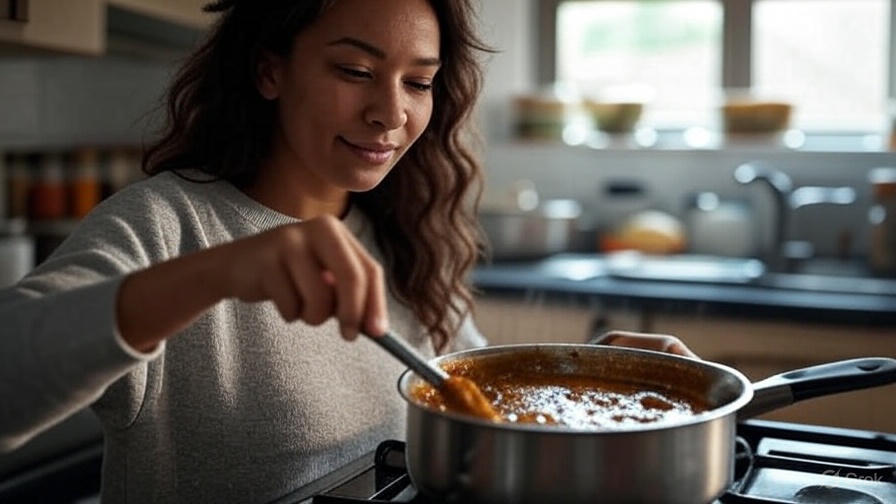How to Make a Curry Less Spicy?
You sit down to enjoy your homemade curry, take the first bite, and suddenly your mouth feels like it’s on fire. Sound familiar? Making a curry too spicy happens to the best of us. The good news is that you don’t have to throw away your hard work or suffer through a tongue-burning meal. Plenty of effective methods exist to reduce spiciness and bring your curry back to a comfortable heat level.
Curry lovers around the world face this challenge regularly. Heat levels vary dramatically between different spices, and what seems like a small amount of chili can sometimes pack an unexpected punch. Learning how to fix an overly spicy curry will save your dinner and help you become a more confident cook.
The Science Behind Spicy Food and Your Taste Buds
Capsaicin causes the burning sensation you feel when eating spicy food. This compound naturally occurs in chili peppers and binds to pain receptors in your mouth. Your body interprets this as heat, which triggers your natural cooling responses like sweating and reaching for water.
Different peppers contain varying levels of capsaicin. Bell peppers have almost none, while habaneros and ghost peppers contain massive amounts. The Scoville scale measures these heat levels, ranging from 0 for bell peppers to over 2 million for the hottest varieties.
Capsaicin dissolves in fats and oils but not in water. This explains why drinking water provides only temporary relief from spicy food. The capsaicin molecules stay in your mouth and continue causing that burning sensation once the water washes away.
Dairy Products: Your First Line of Defense
Dairy products work exceptionally well for reducing curry spiciness. Milk, cream, yogurt, and cheese contain casein protein, which breaks down capsaicin molecules and provides genuine relief from the heat.
Heavy cream produces the most dramatic results. Start by adding two tablespoons to your curry and stir thoroughly. Taste the dish and add more cream gradually until you reach your desired heat level. The richness of cream also enhances the overall flavor profile of most curries.
Plain yogurt offers another excellent option, especially for Indian-style curries. Greek yogurt works particularly well because of its thick consistency and higher protein content. Stir in one tablespoon at a time to avoid making your curry too tangy.
Coconut milk serves as a dairy-free alternative that works almost as effectively. The high fat content helps neutralize capsaicin while adding a subtle sweetness that complements many curry recipes. Full-fat coconut milk produces better results than light versions.
Sweet Solutions That Really Work
Sugar counteracts spiciness by balancing the heat with sweetness. Your taste buds perceive less burn when sweet and spicy flavors combine. This technique works particularly well in tomato-based curries.
Regular white sugar dissolves quickly and provides immediate results. Add one teaspoon at a time, stirring and tasting between additions. Brown sugar adds depth and complexity along with sweetness, making it perfect for rich, dark curries.
Honey creates a more complex flavor profile while reducing heat. The natural enzymes in honey also help break down some of the compounds that cause burning sensations. Use about half the amount of honey compared to sugar, since honey tastes sweeter.
Maple syrup works wonderfully in certain curry styles, particularly those with warming spices like cinnamon and cardamom. The subtle maple flavor enhances the overall taste while taming the heat.
Acidic Ingredients for Heat Reduction
Acid helps balance spiciness by creating contrast on your palate. Lemon juice, lime juice, and vinegar all work effectively to reduce the perceived heat in curry dishes.
Fresh lemon juice brightens the overall flavor while cutting through the spiciness. Squeeze half a lemon into your curry, stir well, and taste. The citrus notes complement most curry spice profiles beautifully.
Apple cider vinegar provides a mild acidity that doesn’t overpower other flavors. Add one tablespoon initially and adjust to taste. Rice vinegar works similarly and pairs especially well with Asian-style curries.
Tomatoes contain natural acids that help reduce spiciness. Canned crushed tomatoes work best because they integrate easily into the curry. Add a quarter cup and simmer for five minutes to allow the flavors to meld.
Dilution Methods That Preserve Flavor
Diluting your curry reduces the concentration of spicy compounds throughout the dish. The key lies in adding ingredients that complement your existing flavors rather than watering down the taste.
Vegetable broth maintains the savory base while reducing heat intensity. Add broth gradually, about half a cup at a time, and simmer to concentrate the flavors again. This method works especially well with vegetable-heavy curries.
Pureed vegetables create bulk without adding liquid. Carrots, potatoes, and cauliflower all work well when cooked and blended into a smooth paste. These vegetables add natural sweetness that helps counteract spiciness.
Extra protein absorbs some of the spicy compounds while making your curry more substantial. Cooked chicken, lamb, or firm tofu all work effectively. The proteins need time to absorb the flavors, so simmer for at least ten minutes after adding them.
Starchy Solutions for Immediate Relief
Starchy ingredients absorb oils and help dilute spicy compounds. These methods work quickly and can rescue an extremely hot curry.
Potatoes absorb tremendous amounts of flavor and spice. Peel and cube two medium potatoes, then simmer them in your curry until tender. You can remove them after they’ve absorbed the excess heat or leave them in as part of the dish.
Rice added directly to curry creates a risotto-like consistency while reducing spiciness. Use uncooked rice and allow it to absorb the liquid as it cooks. This technique works best with saucy curries that have plenty of liquid.
Bread works as an emergency solution. Tear stale bread into pieces and stir it into the curry. Let it simmer until the bread breaks down and thickens the sauce. Remove any remaining chunks before serving.
Advanced Techniques for Serious Heat Problems
Sometimes simple additions aren’t enough for extremely spicy curries. These advanced techniques handle serious heat problems.
Creating a mild curry base helps dilute intense spiciness. Cook onions, garlic, and ginger in oil until fragrant, then add mild spices like turmeric and cumin. Combine this base with your spicy curry in a 1:1 ratio.
Alcohol helps dissolve capsaicin compounds. Wine or beer added to curry not only reduces heat but also adds complex flavors. Use about a quarter cup and let the alcohol cook off completely.
Peanut butter creates richness while absorbing spicy oils. This technique works particularly well in African-inspired curries or Thai-style dishes. Add two tablespoons and stir until completely incorporated.
Prevention Tips for Future Cooking
Learning to control spice levels prevents future mishaps and builds your confidence in the kitchen.
Taste your spices before adding them to curry. Heat levels vary significantly between batches of the same spice. A small taste tells you exactly how much heat you’re working with.
Add spices gradually during cooking. Start with half the recommended amount and build up slowly. You can always add more heat, but removing it requires more effort.
Remove seeds from fresh chilies to reduce heat significantly. The seeds and white membranes contain the highest concentrations of capsaicin. Wear gloves when handling hot peppers to avoid accidentally transferring heat to your eyes or other sensitive areas.
Keep a heat-reducing ingredient on hand whenever you cook spicy food. Having cream, coconut milk, or yogurt ready means you can quickly fix any heat problems that arise.
Different Curry Styles Require Different Approaches
Various curry styles respond better to certain heat-reduction methods. Matching your technique to your curry type produces the best results.
Indian curries often benefit from dairy additions. Yogurt and cream complement the traditional spice profiles beautifully. These curries also respond well to sugar and acidic ingredients like lemon juice.
Thai curries work best with coconut milk additions since most recipes already include this ingredient. Sweet elements like palm sugar or honey also complement the flavor profiles typical in Thai cuisine.
Japanese curry styles respond exceptionally well to additional vegetables and starchy ingredients. Potatoes and carrots fit naturally into these dishes while absorbing excess heat.

Common Mistakes to Avoid
Several common mistakes can make spicy curry problems worse or create new issues.
Never add cold dairy products directly to hot curry without tempering them first. Cold cream or milk can curdle when it hits the hot liquid. Warm dairy products slightly before adding them, or add them very gradually while stirring constantly.
Avoid adding too much of any single ingredient at once. Small, gradual additions allow you to control the final flavor and texture. Large additions can overcorrect the problem and create new issues.
Don’t forget to simmer your curry after making additions. Most heat-reducing ingredients need time to integrate properly with the existing flavors. Five to ten minutes of gentle simmering usually does the trick.
Testing and Adjusting Your Results
Proper tasting technique helps you achieve the perfect heat level. Let your curry cool slightly between tastings to get accurate reads on the spice level. Hot food always seems spicier than it actually is.
Taste from different areas of the pot since heat can distribute unevenly. Stir thoroughly between additions to ensure even distribution of your heat-reducing ingredients.
Consider the heat level your guests prefer. What feels comfortable to you might still be too spicy for others. Err on the side of milder flavors when cooking for groups.
Serving Suggestions for Spicy Curry Recovery
Even after reducing the heat, strategic serving choices can provide additional relief for sensitive palates.
Serve curry over plain rice or with plenty of bread. These starchy sides absorb residual spiciness and provide neutral flavors that balance the heat.
Offer cooling beverages like lassi, milk, or iced tea. These drinks help cleanse the palate between bites and provide ongoing relief from any remaining heat.
Include fresh herbs like cilantro or mint as garnishes. These herbs provide cooling sensations and fresh flavors that complement reduced-heat curries beautifully.
Conclusion
Making a curry less spicy doesn’t have to be complicated or stressful. With the right techniques and ingredients, you can rescue any overly hot dish and turn it into a delicious, comfortable meal. Dairy products, sweet ingredients, acids, and dilution methods all provide effective solutions for different types of heat problems.
The key to success lies in making small, gradual adjustments and tasting frequently. Every curry responds differently to various heat-reduction methods, so patience and experimentation help you achieve the perfect balance.
Remember that cooking spicy food is a skill that improves with practice. Each time you successfully reduce the heat in a curry, you gain valuable experience that makes you a more confident and capable cook. Soon you’ll be able to create perfectly balanced curries with just the right amount of heat every single time.







